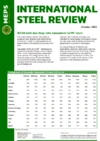Unknown timeline for Baltimore’s coal supply recovery
Several weeks of metallurgical coal supply issues are expected to follow the collapse of the Port of Baltimore’s Francis Scott Key Bridge, despite the opening of two temporary channels.
Delayed supplies of metallurgical coal to steelmakers across the world will be among the knock-on effects of the cargo ship Dali’s March 26 collision with the bridge – triggering its instant collapse.
Around 40 vessels were left trapped in the Port of Baltimore following the incident, which is believed to have claimed the lives of six people. A further 10 ships were left stranded outside the port.
New temporary channels opened
The first vessel to navigate through one of two temporary shipping channels planned for the Port of Baltimore made its passage on April 1, less than a week after the bridge collapsed.
The tugboat, pushing a fuel barge, passed through the channel, which has a depth of just 11 feet. A second channel, for vessels with a draft of up to 15 feet, opened late yesterday (April 3).
No timeline has been set for the opening of the Patapsco River to the large ships that transport the port’s main cargos of coal and cars, however. Cargo ships like the Dali can have a draft of over 50 feet.
U.S. Coast Guard Commander Baxter Smoak, operations section chief of the Key Bridge Response 2024, said: “Our number one priority remains the opening of the deep draft channel. We are simultaneously focused on opening additional routes of increased capacity as we move forward.”
Maryland governor Wes Moore has described the Key Bridge collapse as a “national economic disaster”.
Efforts are currently being made to divert imports and exports away from the Port of Baltimore, but the negative effects on supply chains are likely to be felt for some time.
The Hampton Roads port – some 300km away – is understood to have additional capacity to export metallurgical coal to steelmakers, but diverting cost will likely add to freight costs.
Supply delays and added cost
CSX and Consol Energy, which operate two full-service terminals that receive, store, and load coal onto ocean-going vessels at the port, have warned of supply delays.
Data from the US Energy Information Administration (EIA) shows that the Port of Baltimore is the United States’ second biggest coal export location. In the 2019 to 2023 period, between five and nine million tonnes of metallurgical coal were among the 25m tonnes of coal shipped from the port annually, to destinations in Asia, Europe and South America.
EIA data showed that Japan was the main recipient of metallurgical coal from the Port of Baltimore in 2023, receiving 28% of its exported material.
Baltimore warehouses registered with the London Metal Exchange also contain around 756 tonnes of nickel, 150 tonnes of tin and 50 tonnes of copper.
Automotive imports are a large part of the traffic entering the Port of Baltimore. Last year almost 850,000 cars passed through its docks.
In total, 52.3 million tonnes of imports, worth USD80.8bn, passed through Baltimore during 2023, according to data from the state of Maryland.

Source:
International Steel Review
The MEPS International Steel Review is an essential monthly publication, offering professional analysis and insight into carbon steel prices around the world.
Go to productRequest a free publication





